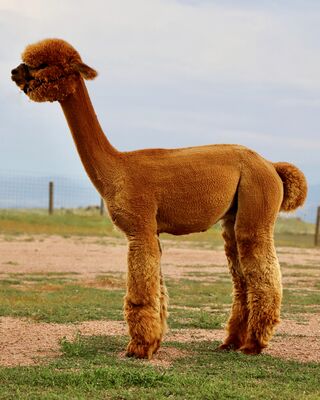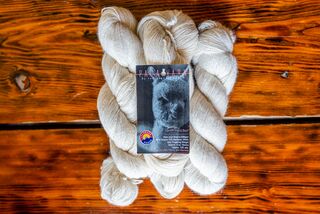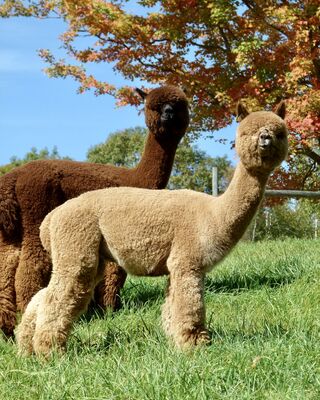About Alpacas
Alpacas are a domesticated member of the camelid (camel) family. The camelid family also includes llamas, guanacos, and Vicuñas from South America, and the Bactrian and Dromedary camels from Asia and Africa.
This family of animals originated on the plains of North America about 10 million years ago.
A common ancestor to the South American camelids migrated to South America about 2.5 million years ago. Two wild species, Vicuñas and guanacos, emerged. They still live in the Andes Mountains today. It is believed that 6,000 years ago alpacas were created trough selective breeding which was heavily influenced by the Vicuña. There are similarities in size, fiber, and dentition (teeth) between the alpaca and the wild Vicuña.
Today, there are about 3.5 million alpacas in the Andean highlands, most of which can be found in Peru. Since the major first importation into the United States in 1984, the North American herd has increased from a few alpacas in zoos and private collections to over 100,000. Alpacas are popular internationally for their luxury fiber and as pet, show and investment animals in Canada, England, Australia, New Zelma’s, Poland, France, and Israel, as well as the United States.
- - - -
Physical Facts:
Life Span: 15 to 20 years
Height: 32” to 39” at the shoulder
Birth Weight: 10 to 19 pounds
Adult Weight: 100 to 190 pounds
Health:
While hardy and generally disease resistant, basic care of yearly vaccinations, worming, and regular toe and occasional dental care is recommended. Alpacas are shorn every 12 to 18 months to harvest their exquisite fleece, and for health and management purposes.
Reproduction, Birth & Offspring:
Male alpacas reach sexual maturity at about 2 1/2 years of age. Female are first bred at 16 to 20 months of age. Like other South American camelids, alpacas do not have a heat (estrus) cycle and can be bred any time of the year. An average gestation of 355 days produces a sing baby alpaca (cria) which is usually delivered from a standing position during daylight hours. Twinning is extremely rare and rarely compatible with life, though there has been quite a few sets of twins in the recent years who are thriving!
Breeds, Fiber, & Color:
The two breed types are the huacaya and the suri. Both fleeces are soft and free of guard hair (or they generally should be). Ninety percent of alpacas are huacaya, with full, puffy fleeces whose crimp or curvature is in the individual fibers. The lustrous, straight fiber of the suri fleece hands down, giving the suri alpaca an entirely different appearance. Fibers of both breed types are c onside red luxury fiber in the textile trade because of their unique qualities. Yearling alpacas (12 to 20 months) alpacas generally provide the finest most useable fleeces. Depending upon its weigh, quality, and cleanliness an alpaca fleece commands $200 to $400. The six basic colors are white, fawn, brown, black, gray (rose, silver, and modern), brown,
Tuesday, October 18, 2022




